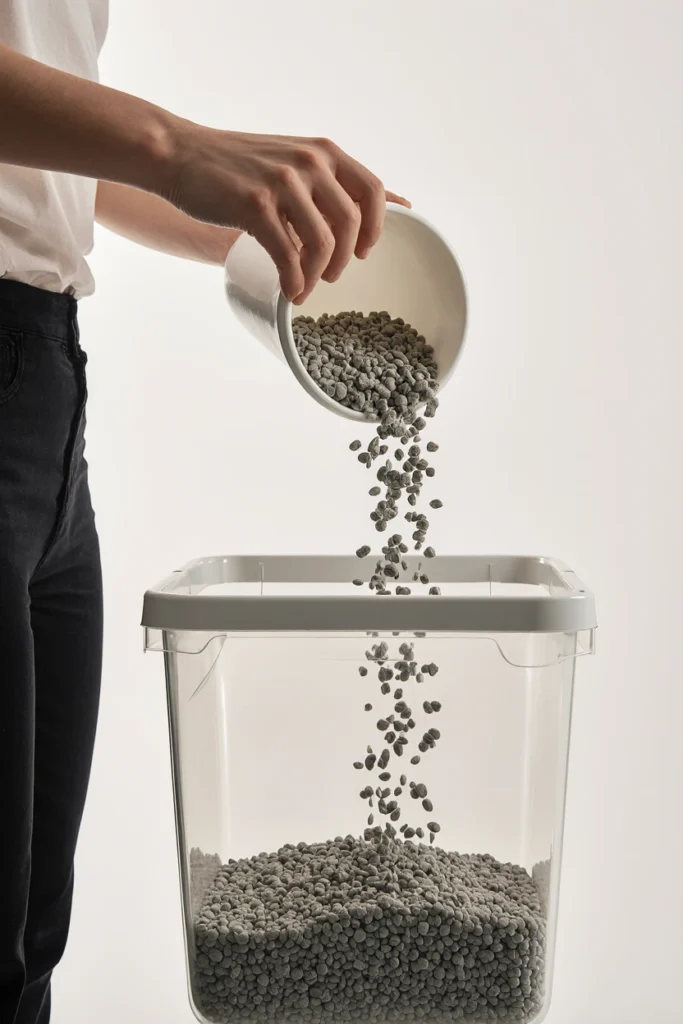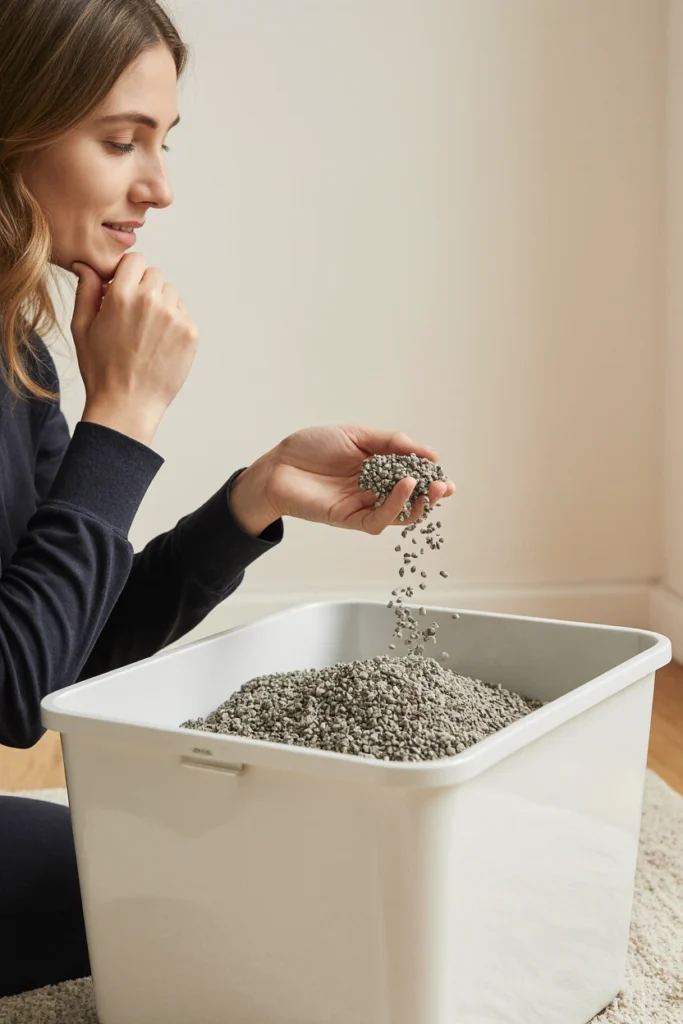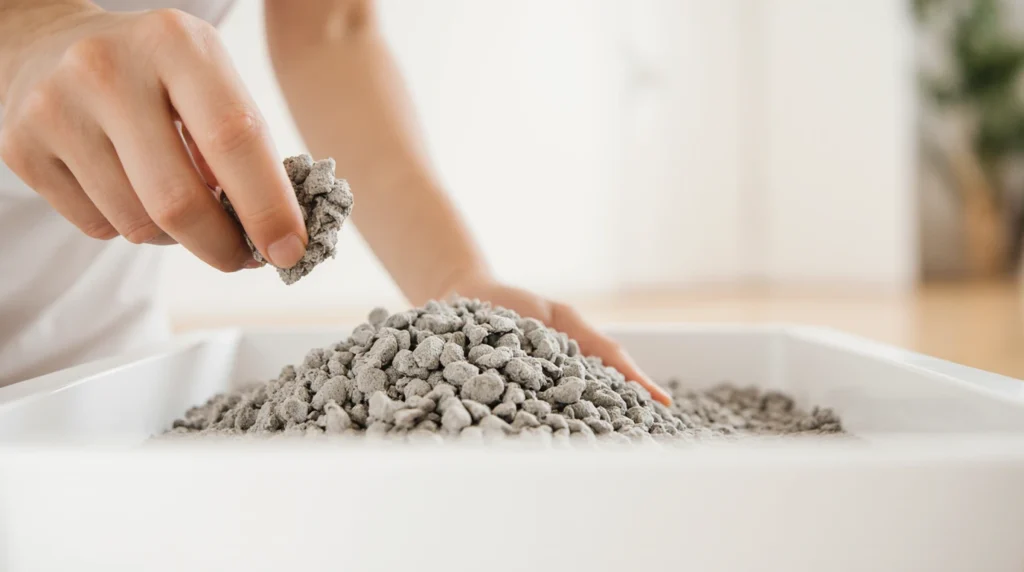Cat Litter Clumping If you’ve ever stood frozen in the pet aisle, staring down an army of cat litter bags, wondering why some cost double and others promise things like “health monitoring crystals” or “instant odor locking,” you’re not alone. The truth? Choosing the right clumping cat litter isn’t just about keeping the box tidy — it can affect your cat’s health, your home’s air quality, and yes, even your budget.
At first glance, it all sounds the same: it clumps, you scoop, done. But dig a little deeper (pun fully intended), and you’ll uncover a whole world of materials, performance differences, environmental impacts, and user regrets. Some litters turn into wet cement. Others track like glitter after a kids’ party. Some seem perfect until your cat flat-out refuses to use them. It’s not just about clumping — it’s about clumping well.
This guide breaks it all down — what makes a good clumping litter actually good, how to decode misleading packaging, which formulas work best for different cat types and households, and how to avoid the top mistakes even experienced owners make.
By the end, you won’t just pick a litter — you’ll pick one that your cat actually likes, that doesn’t choke you with dust, and that doesn’t cost a small fortune over time.
Table of Contents

What Is Clumping Cat Litter and Why It Changed the Game
Let’s rewind a bit. Before clumping litter hit the shelves, cat owners had to deal with messy, saturated litter boxes that needed full dumps every couple of days. Enter clumping litter — and suddenly, cleaning became as easy as scoop and go. But how does it actually work?
Most clumping cat litters are made from sodium bentonite clay, a natural material that swells and binds tightly when wet. When your cat pees, the liquid activates the clay, forming dense, scoopable clumps. That’s the main appeal: it isolates waste and locks in odor — no need to dump the whole box unless you’re doing a full refresh.
But here’s where it gets nuanced. Not all clumping litters are created equal. Some brands form loose or sticky clumps that fall apart when scooped. Others turn into heavy, wet sludge. The ideal clumping litter forms firm, dry clumps that stay intact, scoop cleanly, and minimize odor — without leaving behind dust clouds or turning into a tracking nightmare.
Types of Clumping Litters
While clay remains king, alternatives have gained traction:
- Corn-based (like World’s Best): Lightweight and flushable, but can mold in humid environments.
- Wood or pine: Natural-smelling, compostable, but clump strength varies.
- Grass seed: Soft on paws, decent odor control, biodegradable.
- Walnut shells: Darker appearance, eco-friendly, great for odor.
- Crystals (silica gel): Not technically clumping, but absorbs moisture; some come with color-changing health indicators.
Each of these has tradeoffs in clump strength, dust levels, scent, environmental footprint, and cat preferences. And yes — your cat may vote with their paws (and your carpet) if they don’t like the texture or smell.
What’s the Benefit of Clumping vs Non-Clumping Litter?
Clumping litter:
- Easier spot-cleaning — scoop only the dirty parts.
- Better odor containment between full cleanings.
- More economical in the long run (less total waste).
Non-clumping litter:
- Sometimes better for kittens or post-surgery cats.
- Can absorb more liquid per scoop — but harder to isolate waste.
- Often cheaper upfront — but needs more frequent changes.
FAQ – Can You Flush Clumping Cat Litter?
Short answer: No — at least, not most types.
While some natural clumping litters (like corn- or wheat-based ones) are labeled flushable, many municipalities still advise against it. Clay litter should never be flushed, as it can clog pipes and isn’t biodegradable. Always check local guidelines — and when in doubt, trash it.
Clay vs Natural: Clumping Cat Litter Material Showdown
If you’ve browsed litter bags lately, you’ve probably noticed a growing split: traditional clay-based litters on one side, and a surge of natural alternatives on the other. The choice isn’t just aesthetic or trendy — it reflects real tradeoffs in performance, cost, sustainability, and even feline preference.
Let’s break it down.
Clay-Based Clumping Litter: The Longstanding Champ
Clay litters, particularly those made with sodium bentonite, are beloved for one main reason: they clump fast and hard. This makes scooping easy and odor control highly effective. Most top-rated products (like Dr. Elsey’s Ultra or Fresh Step) rely on this material.
Pros:
- Excellent clump strength — minimizes mess during scooping.
- Great at locking in odors quickly.
- Widely available and affordable.
Cons:
- Heavy (shipping or lifting large bags = shoulder workout).
- Can be dusty — not ideal for cats or owners with respiratory sensitivities.
- Non-biodegradable and strip-mined — environmentally taxing.
So if convenience and performance are your top priorities, clay wins — but it’s not without compromises.
Natural Alternatives: Eco-Friendly But Varying in Power
Eco-conscious owners often turn to plant-based litters. These use renewable resources like corn, wheat, walnut shells, or wood fibers, and most are biodegradable.
Common types:
- Corn (e.g., World’s Best) – Flushable, lightweight, clumps decently. Can smell musty in humid climates.
- Wheat – Soft texture, decent clumping, naturally odor-absorbing.
- Walnut shell – Dark appearance hides waste, solid odor control, mid-range clumping.
- Pine/Wood – Fresh scent, low tracking, low clumping power unless pelletized versions are modified.
- Grass seed – Silky texture cats love, strong clumping, great for sensitive paws.
Pros:
- Renewable, compostable (some types), lighter.
- Often lower in dust.
- Better for septic systems (when labeled flushable).
Cons:
- Weaker clumping with some types.
- Higher price tags per pound.
- Less odor control than clay in multi-cat homes.
And here’s a twist: PrettyLitter, made of silica crystals, adds health-monitoring tech by changing color based on urine pH — super handy, but doesn’t actually clump.
Which Clumping Litter Material Is Best?
There’s no one-size-fits-all. If your cat has asthma, a dust-free natural option might be worth it. If you’ve got four cats and no time to play scooper detective? A heavy-duty clay like Boxiecat or Fresh Step might be your winner. Some owners even mix litters to get the best of both worlds (e.g., add some corn to a clay base to reduce weight and dust).
FAQ – Is Natural Clumping Litter Really Better for the Environment?
Short answer: Mostly, yes — but with caveats.
Natural litters use renewable resources and are often compostable (if not contaminated with feces). However, the production, packaging, and shipping still carry an environmental cost. Also, unless you compost properly, they may end up in landfills like clay anyway. So yes, better — but not a perfect green solution.
Performance Breakdown: Clump Strength, Odor Control, Tracking & Dust
Let’s be honest — most litter brands promise the moon. “99.9% dust-free,” “locks in odor for 14 days,” “superior clumping technology.” But the real test? That moment you scoop and either get a clean, dry clump… or a sticky crater of regret.
This section breaks down the four key performance factors that make or break your litter experience — clump integrity, odor control, tracking, and dust.
1. Clumping Strength: The Scoop Test
Strong clumping isn’t just about ease — it’s about hygiene. When urine seeps through and clumps weakly, you end up with a mucky base that stinks faster and invites bacteria.
Top performers (per user tests):
- Dr. Elsey’s Ultra – forms firm, sand-like clumps that lift easily.
- Boxiecat – praised for “flat top” clumps that don’t sink.
- World’s Best (corn) – lighter clumps, decent for a natural base.
Watch out for:
- Crystal-based litters (PrettyLitter) – no clumping; absorbs moisture instead.
- Some cheaper clay brands that form sticky or glue-like clumps.
2. Odor Control: Cover-Up or Chemical Cloud?
Odor management isn’t just about trapping smell — it’s about how it’s done. Many litters rely on activated charcoal, baking soda, probiotics, or fragrance to mask or neutralize odor.
User-tested insights:
- Fresh Step with Febreze is polarizing — powerful but perfume-heavy.
- Naturally Fresh (walnut) uses natural odor-absorbing properties, with milder scent.
- PrettyLitter excels for short-term ammonia control but needs frequent stirring.
Pro tip: Odor is highly subjective — and what smells “fresh” to one cat may smell like synthetic doom to another.
3. Tracking: When the Box Leaves the Box
Let’s be real — no litter is truly non-tracking. But some are definitely worse than others. Fine-grain clay or silica? Your floors know them too well.
Low-track champs:
- Boxiecat & ökocat – larger granules stay put.
- Pine pellets – heavy, barely track, but minimal clump.
High-track offenders:
- Lightweight clay (e.g., Tidy Cats Lightweight) and fine crystals.
Pro tip: High-sided or top-entry boxes help more than any litter can.
4. Dust Levels: The Silent Aggravator
Some litters claim “dust-free,” but crack open the bag and you’re hit with a small sandstorm. Dust matters — for your lungs and your cat’s.
Low-dust options:
- Dr. Elsey’s Respiratory Relief
- Boxiecat Extra Strength
- ökocat wood fiber
High-dust culprits:
- Cheaper clays or store brands
- Overused crystal litters without airflow
FAQ – What’s the Best Clumping Litter for Multiple Cats?
For homes with 2+ cats, look for litters labeled “multi-cat strength.” Top contenders:
- Dr. Elsey’s Ultra
- BoxiePro
- Arm & Hammer Clump & Seal Platinum
These formulas tend to have extra odor-fighting additives and stronger clumping properties, built to handle the higher traffic — and higher pee volume.

The Best Clumping Cat Litters: Real Reviews & Scorecards
With dozens of options on the shelves — each with its own buzzwords and bold claims — choosing the right clumping litter can feel like trial by dust cloud. So we did the digging. Here’s how the most popular and highest-rated clumping litters stack up in the real world — not just on paper.
Each product below is scored based on clump strength, odor control, dust level, tracking, and value. These aren’t lab tests — they’re compiled from actual user feedback, expert reviews (like Cats.com), and vet opinions where available.
1. Dr. Elsey’s Ultra Cat Litter – Cat Litter Clumping
Type: Clay
Best for: Multi-cat households, high odor control
Scorecard:
- Clumping: ★★★★★
- Odor Control: ★★★★★
- Dust: ★★★☆☆
- Tracking: ★★★☆☆
- Value: ★★★★★
Why it’s great: A go-to for cat parents who want reliability over novelty. Heavy granules form rock-solid clumps. Great for homes with 2+ cats.
Downside: It’s heavy — hauling a 40lb bag is not for the faint of arm.
2. Boxiecat BoxiePro – Cat Litter Clumping
Type: Clay + probiotics
Best for: Low-dust lovers, germ-conscious owners
Scorecard:
- Clumping: ★★★★★
- Odor Control: ★★★★☆
- Dust: ★★★★★
- Tracking: ★★★★☆
- Value: ★★★★☆
Why it’s great: Innovative probiotic blend helps fight invisible waste bacteria. Its “flat-top clump” structure is uniquely scoop-friendly.
Downside: More expensive than standard clay litters.
3. PrettyLitter – Cat Litter Clumping
Type: Silica crystals
Best for: Health monitoring, minimal scooping
Scorecard:
- Clumping: ☆☆☆☆☆
- Odor Control: ★★★★☆
- Dust: ★★★★☆
- Tracking: ★★★★☆
- Value: ★★★☆☆
Why it’s great: Changes color to detect urinary issues — brilliant for catching problems early. Lightweight and monthly-subscription based.
Downside: Doesn’t clump — requires daily stirring. Not ideal for multiple cats.
4. World’s Best Cat Litter (Multiple Cat Formula) – Cat Litter Clumping
Type: Corn
Best for: Eco-conscious households, flushability
Scorecard:
- Clumping: ★★★★☆
- Odor Control: ★★★☆☆
- Dust: ★★★★☆
- Tracking: ★★★☆☆
- Value: ★★★★☆
Why it’s great: Biodegradable, lightweight, and flushable (if you dare). Surprisingly effective for a non-clay base.
Downside: Can mold if exposed to humidity. Some cats dislike the texture.
5. Arm & Hammer Clump & Seal Platinum – Cat Litter Clumping
Type: Clay + baking soda
Best for: Max odor control
Scorecard:
- Clumping: ★★★★☆
- Odor Control: ★★★★★
- Dust: ★★★☆☆
- Tracking: ★★★☆☆
- Value: ★★★★☆
Why it’s great: Powerful odor locking with baking soda and “seal” tech. Often praised by owners with picky noses.
Downside: Scented — which not all cats tolerate well.
FAQ – What’s the Best Litter for Cats with Respiratory Issues?
Answer: Look for low-dust, unscented litters. Top options:
- Boxiecat Extra Strength
- Dr. Elsey’s Respiratory Relief
- ökocat Dust-Free Formula
Avoid anything with heavy fragrance or visible dust when pouring — those are lung irritants for both cats and humans.
Who It’s Best For: Matching Clumping Litter to Your Cat and Home
Here’s a truth you rarely see on a product label: no cat litter works perfectly for everyone. What works like a dream in a studio apartment with one finicky senior cat might be a total fail in a four-cat household with kittens and a dog sniffing around the box.
So let’s stop pretending there’s a universal “best” and instead talk about who each type of clumping litter actually works best for.
🐾 If You Have a Multi-Cat Household
Look for: Heavy-duty clumping + max odor control.
- Best picks: Dr. Elsey’s Ultra, Arm & Hammer Clump & Seal Platinum
- Why: You need fast, strong clumps and serious odor defense — lightweight formulas just won’t cut it when four cats are on rotation.
🧓 If You Have a Senior Cat or One With Arthritis
Look for: Soft texture, low-dust, unscented.
- Best picks: World’s Best (corn), Boxiecat Extra Strength
- Why: Older cats may avoid litters that feel too gritty or are heavily perfumed. Plus, dusty litters can aggravate respiratory issues.
🐱 If You Have Kittens
Look for: Non-toxic, non-clay, unscented.
- Best picks: Grass seed litter, pine pellets, or World’s Best (carefully monitored)
- Why: Kittens are lickers. You don’t want them ingesting sodium bentonite or silica dust. Many vets recommend avoiding clumping litters entirely until 3–4 months of age.
🌿 If You’re Eco-Conscious
Look for: Biodegradable, compostable materials.
- Best picks: ökocat, World’s Best, Naturally Fresh (walnut), grass seed
- Why: Clay is strip-mined and non-renewable. Natural litters help shrink your pet’s carbon pawprint — but may require more frequent box changes.
🧪 If You Want Health Monitoring
Look for: Silica-based litters with color-changing tech.
- Best pick: PrettyLitter
- Why: It can alert you to changes in urine pH (e.g., UTIs or kidney issues) before symptoms show — especially useful for cats prone to urinary issues.
🏠 If You Have Limited Space or Poor Ventilation
Look for: Maximum odor control, low tracking.
- Best picks: Arm & Hammer Platinum, BoxiePro
- Why: In small spaces, even one missed scoop can turn into a sensory nightmare. Choose a litter that clumps instantly and locks down smells.
FAQ – Should I Let My Cat Decide the Litter?
Honestly? Yes.
Cats have preferences. Some won’t tolerate pine. Others will boycott anything with fragrance. If your cat is avoiding the box or pooping just outside of it, the litter is often the issue — not the behavior. Try small bags of a few types and observe. Their paws will tell you what they think.
Health & Safety: What Most Brands Don’t Tell You About Clumping Litter
We don’t talk about litter safety enough. For something that’s constantly under our cats’ noses (and ours), clumping cat litter can pose hidden risks — especially when brands prioritize odor masking over transparency.
Let’s break down the real health concerns, from respiratory hazards to litter ingestion, so you’re not left wondering if that mystery cough or box boycott is more than just “cat quirks.”
🚫 The Dust Problem: More Than a Minor Irritant
Many clay litters claim to be “99.9% dust-free” — a number that sounds great until you open the bag and get hit with a cloud of micro-particles. For cats with asthma or respiratory sensitivities (and for humans with allergies), that dust can be a silent trigger.
Symptoms to watch for:
- Sneezing after digging or scooping
- Red or watery eyes
- Wheezing or coughing — especially in older or flat-faced breeds
Safer options:
- Boxiecat Extra Strength (truly low-dust clay)
- Dr. Elsey’s Respiratory Relief
- ökocat wood-based fibers (minimal airborne particles)
🧪 Chemical Scents & Fragrances: What’s Hiding in the “Fresh”?
Some litters fight odor with heavy synthetic fragrances. If you’ve ever recoiled at the artificial “meadow breeze” as your cat digs, your cat probably hates it too.
What’s at risk:
- Fragrance sensitivities (which cats have in spades)
- Skin irritation from scent additives
- Litter aversion or box refusal
Look for: Unscented formulas that use baking soda or activated charcoal instead. Trust your nose — if it smells fake, your cat likely thinks it smells worse.
☠️ Ingestion Risks: When Curiosity Turns Risky
Kittens are the usual culprits here, but even adult cats can accidentally ingest litter when grooming paws. Sodium bentonite clay expands with moisture — which is great for clumps, but dangerous if swallowed.
Red flags:
- Vomiting, constipation, or odd stools in kittens
- Licking the paws excessively after using the box
Better for young cats:
- Grass seed, pine, or paper-based litters during early months
- Avoid clumping altogether until ~12 weeks
🌊 Flushability Myths: What’s Actually Safe?
Some plant-based litters (corn, wheat, etc.) are labeled “flushable.” But here’s the catch: most city plumbing systems and septic tanks aren’t built for litter — even the natural kind.
Potential issues:
- Pipe blockages
- Toxoplasmosis risk in flushed waste (can impact water systems and wildlife)
- Illegal in some areas (e.g., California discourages flushing cat waste)
Verdict: Just because it can be flushed doesn’t mean it should be.
FAQ – Is Clay Litter Safe Long-Term?
Answer: In moderation, yes — but it depends on the cat and the brand.
If your clay litter is low-dust, unscented, and doesn’t cause irritation, it’s generally considered safe for long-term use. However, always watch for subtle signs: sneezing, refusal to use the box, or excessive paw licking can all be signs that it’s time to switch.


